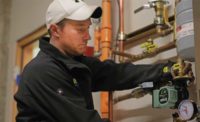There are a plethora of issues in the HVAC industry these days, so The NEWS talked to some industry leaders to get their ideas on the concerns and trends that HVAC contractors are faced with on a daily basis.
NEWS: The HVAC industry — at least according to shipment numbers from Air-Conditioning, Heating and Refrigeration Institute (AHRI) — has grown every year since 2011. What do you attribute that growth to and how long can it continue?
Kevin McNamara, senior vice president and general manager, LG Air Conditioning Technologies: Go back to 2008, and we see how hard and quickly the economy crashed. But then think about how quickly it came back. The past 10 years, the economy and the industry have experienced tremendous growth and prosperity. Because of changes to the tax code, foreign investment, and consumer optimism, the economy has seen a substantial uptick of spending across a number of industries. Money has been pumped into this economy at an incredible pace and, unfortunately, most people are trying to predict the end of it rather than extending it. There has been plenty of business to go around. As new facilities are being built and older ones are being renovated or repurposed, the story of comfort, technology, and efficiency going hand in hand does not change. For the time being, we remain cautiously optimistic and do not see a dropoff in activity.
Nathan Walker, senior vice president, Goodman Mfg. Co.: There are many different reasons, but you can look at the period from the mid-1990s to 2006, where the new construction market exploded, but then it capped out. There was an extraordinary amount of residential home building during that time. Those installations are now entering the replacement segment of the HVAC marketplace. I think that is driving some of the growth. It is the maturing population of units combined with strong economic conditions. We look at consumer confidence levels as part of our market forecast model. Over the past couple of years, it has been growing. It all bundles together so that homeowners start accepting the replacement of an HVAC system instead of repairing an older, less energy-efficient system.
Chris Day, director of product management, marketing, and training; Rheem Mfg. Co.: Construction predictions are continuing to rise, and NAHB [National Association of Home Builders] forecasts are pointing toward increases as well, signifying strong indicators of growth.
Scott Intagliata, marketing director, Unico System: Things are going well, but obviously, sooner or later, we will see a slowdown. Hopefully, that does not happen anytime soon. When it does, you need to focus significantly on profit. If we don’t hit our sales projections, we do what we need to do through the rest of the company to make sure the profit goal is still hit. Cash management is key.
NEWS: If you were talking to a contractor who wanted to grow their business, what one item would you tell them to add?
Philip Windham, president, Nortek Global HVAC: If you want to be more profitable quicker, add financing. If you want to build a book of business that has value down the road, add service agreements.
Walker: The entire HVAC supply chain often acts like it is 15 years ago. Back then, contractors used phones with cords and no computers to conduct business. I encourage contractors to develop an online business strategy. Simply hating internet sales is not an online strategy. Contractors need to use new tools and technology to bolster their reputation in the local market. I encourage contractors to address the different ways consumers are interacting with the HVAC market. You can’t control what potential customers do, but you can take advantage of what they decide as long as you maintain a flexible attitude to changing market conditions.
Intagliata: We are trying to get more of our contractors to take up financing. We brought in a big player in the market to help us do that. Contractors do not offer financing nearly as much as we would like. End users love it.
NEWS: The ductless market has grown in market share and has also made its fair share of news lately. What is your opinion on that part of the market?
McNamara: You have a segment of the market that is looking at building more efficient homes, more comfortable homes, and homes that use the latest technology. When we get out and tell the story about how these systems are more efficient to run and provide comfort — that gets people’s attention. It’s not the mass construction market, but it plays well to certain segments of the market. The premium market is growing at a higher rate than the standard market in many parts of the country, and that is where this technology fits. It is why all the traditional systems’ players are joining the inverter and ductless segment — because they see the growth in the technology’s adoption and want to be in this business. It is not the future, it is the present.
Day: Rheem has made investments in ductless over the past couple years. When we entered the space, we were fortunate to partner with Fujitsu, and we continue to add to this portfolio regularly. Now that the market has gotten to the point of it being viewed as a whole-home or multifamily solution — and not just a garage add-on — the growth will continue. It is effectively being used, and we are excited about its potential.
Walker: We see continued growth in the double-digit range. Several reasons support my comment. The No. 1 item is that heat pump technology has improved so that the products are performing better in colder climates. As you look at the Northeast and Northwest, where a lot of the growth is occurring, you see it delivers more value than even two to three years ago. In North America, the ductless market started as an add-on above the garage. Today, ductless systems work well in single rooms or whole-home installations. Also, we see that some ducted and ductless product lines are starting to blur a bit. Product availability is a big part of the growth of ductless products as well. As distributors have products and dealers get more access to them, they are going to find applications where they have not thought of them in the past. It might sound too simple, but improvements in technology and a readily available supply of products are enough to support increased market growth. Even though ductless products were very popular in the rest of the world, the North American market is still in the early stages of market growth potential.
NEWS: How does this industry solve the workforce development problem?
Windham: We have to make HVAC sexy. Or as sexy as we can. At the end of the day, we provide optimized indoor climates that impact everyone who walks into them. It is kind of a big deal at the end of the day. We have to figure out how to market the trades as an on par option to the traditional collegiate path. That goes all the way to high school guidance counselors who probably took the college path. We need to make them aware of the trades. There is a significant opportunity there to do some guerilla marketing tactics to attract talent. The military never shows people marching in line and doing pushups and the other things you do in boot camp. They show you wearing cool night vision goggles and flying jets. I think there is an opportunity to drive the HVAC message in a flashier direction.
McNamara: This is not a new problem. This has been going on for 30 years. It was such a disservice to high school kids when we took vocational education out of curricula. LG is actively working with community colleges through helping them create labs for hands-on education. Because it is not in high schools, community colleges have an excellent opportunity to step up and provide this kind of education. We are always looking for opportunities to partner up as a manufacturer to facilitate establishing these programs. At some point, school systems will need to figure out how they are going to engage with kids who are looking for these types of career opportunities that are out there. Everything is local, so get involved.
Day: Workforce development starts with establishing robust training that our customers can use. We’ve invested heavily in training programs that can be taken in any one of our Innovation Learning Centers or in the field. We also invest in local vocational programs and encourage contractors to do the same, in addition to developing apprenticeship programs. We want to help show the potential skilled trade force that they have a great opportunity in HVAC.
NEWS: What is the biggest trend that you see coming down the road for the HVAC contractor that they might not realize yet?
Windham: Consumers are getting smarter every day because of the information they have available to them. More and more people are figuring out how to get equipment online, and more and more contractors are willing to do installation-only work — much more than two to five years ago. Amazon has changed the landscape as far as expectations of service and delivery. But Google is a big player there, too, and they are making an interesting play. Instead of just being a provider of the local contractor through PPC [pay per click] or natural search results, they have Local Google, where contractors are paying big money like an Angie’s List model. Google is playing in that market now. They are saying that they will bring just three contractors into a search result and that is going to be it. That is going to change the landscape for the little contractors. They are not going to be able to afford to pay to play.
Walker: There are more ways to solve indoor comfort issues than there has ever been in my lifetime. The product lines that are available today far exceed the levels of energy efficiency, quality, and technology that were available previously. Contractors who are growth-minded should take a look at all those products and not look at the problems they encounter the same way they did years ago. HVAC contractors are in the comfort solution business, and they should embrace all the tools available to ensure that they are ready to resolve any need from their next customer.
Publication date: 11/19/2018
Want more HVAC industry news and information? Join The NEWS on Facebook, Twitter, and LinkedIn today!










